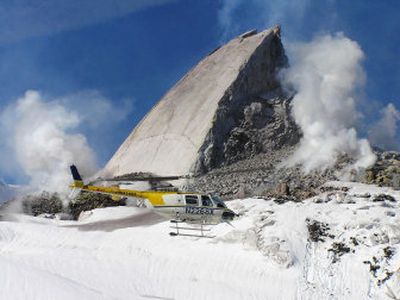Volcano view spot reopens with new rock slab in view

SEATTLE – Visitors to the Johnston Ridge Observatory at the Mount St. Helens National Volcanic Monument can look forward to a spectacular view of a hulking slab of rock that’s rapidly growing in the volcano’s crater.
It’s jutting up from one of seven lobes of fresh volcanic rock that have been pushing their way through the surface of the crater since October 2004.
The fin-shaped mass is about 300 feet tall and growing 4 feet to 5 feet a day, said Dan Dzurisin, a geologist at the U.S. Geological Survey.
The observatory opened for the summer season on Friday. The day dawned with clear blue skies over the southwest Washington volcano, with snow-covered features within the crater easily visible from a Web camera at Johnston Ridge. The National Weather Service said clouds should move in today, with rain likely Sunday.
The rock in the crater began growing last November, steadily moving west and pushing rock and other debris out of its way as it goes.
Mount St. Helens has been quietly erupting since a flurry of tiny earthquakes began in late September 2004. Scientists initially mistook the quakes as rainwater seeping into the hot interior of the older lava dome.
But it soon became clear that magma was on the move, confirmed by the emergence of fire-red lava between the old lava dome and the south crater rim a few weeks after the seismic activity began.
The volcano has continued pumping out lava ever since. Eventually, scientists expect the volcano will rebuild its conical peak that was obliterated in the May 18, 1980, eruption that left 57 people dead.
The current growth of the new lava dome has been accompanied by low seismicity rates, low emissions of steam and volcanic gases and minor production of ash, the USGS said.
“Given the way things are going now, there’s no hint of any sort of catastrophic eruptions,” USGS geologist Tom Pierson said. “At any time, however, things can change.”
Scientists flew a helicopter into the crater late last week to adjust equipment and take photographs that will likely be used to determine just how much the new lava dome has grown the last several months.
The Johnston Ridge Observatory, which closes down every winter, is the closest observatory to the 8,364-foot peak. It is named after David A. Johnston, a volcanologist killed in the 1980 eruption. It sits about five miles north of the mountain and offers the closest views of the volcano’s horseshoe-shaped crater.